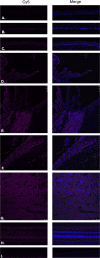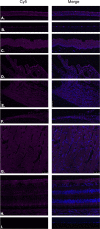Expression of hypothalamic neurohormones and their receptors in the human eye
- PMID: 28977997
- PMCID: PMC5620137
- DOI: 10.18632/oncotarget.18358
Expression of hypothalamic neurohormones and their receptors in the human eye
Abstract
Extrapituitary roles for hypothalamic neurohormones have recently become apparent and clinically relevant, based on the use of synthetic peptide analogs for the treatment of multiple conditions including cancers, pulmonary edema and myocardial infarction. In the eye, it has been suggested that some of these hormones and their receptors may be present in the ciliary body, iris, trabecular meshwork and retina, but their physiological role has yet to be elucidated. Our study intends to comprehensively demonstrate the expression of some hypothalamic neuroendocrine hormones and their receptors within different retinal and extraretinal structures of the human eye. Immunofluorescence, Western blot analysis, and RT-PCR were used to evaluate the qualitative and quantitative expression of Luteinizing Hormone Releasing Hormone (LHRH), Growth Hormone Releasing Hormone (GHRH), Thyrotropin Releasing Hormone (TRH), Gastrin Releasing Peptide (GRP) and Somatostatin as well as their respective receptors (LHRH-R, GHRH-R, TRH-R, GRP-R, SST-R1) in cadaveric human eye tissue and in paraffinized human eye tissue sections. The hypothalamic hormones LHRH, GHRH, TRH, GRP and Somatostatin and their respective receptors (LHRH-R, GHRH-R, TRH-R, GRPR/BB2 and SST-R1), were expressed in the conjunctiva, cornea, trabecular meshwork, ciliary body, lens, retina, and optic nerve.
Keywords: eye neuropeptides; hormone-analog therapy; ocular endocrinology.
Conflict of interest statement
CONFLICTS OF INTEREST Dr. Norman Block states that he is a Founder of Biscayne Pharmaceuticals Inc.. The authors have nothing else to disclose
Figures











Similar articles
-
The interaction of growth hormone releasing hormone with other hypothalamic hormones on the release of anterior pituitary hormones.Clin Endocrinol (Oxf). 1986 Feb;24(2):149-56. doi: 10.1111/j.1365-2265.1986.tb00757.x. Clin Endocrinol (Oxf). 1986. PMID: 2871949
-
Thyrotropin-Releasing Hormone (TRH) and Somatostatin (SST), but not Growth Hormone-Releasing Hormone (GHRH) nor Ghrelin (GHRL), Regulate Expression and Release of Immune Growth Hormone (GH) from Chicken Bursal B-Lymphocyte Cultures.Int J Mol Sci. 2020 Feb 20;21(4):1436. doi: 10.3390/ijms21041436. Int J Mol Sci. 2020. PMID: 32093298 Free PMC article.
-
Antagonists of growth hormone releasing hormone (GHRH) and of bombesin/gastrin releasing peptide (BN/GRP) suppress the expression of VEGF, bFGF, and receptors of the EGF/HER family in PC-3 and DU-145 human androgen-independent prostate cancers.Prostate. 2005 Aug 1;64(3):303-15. doi: 10.1002/pros.20262. Prostate. 2005. PMID: 15754342
-
Ectopic secretion of growth hormone-releasing hormone (GHRH) in neuroendocrine tumors: relevant clinical aspects.Ann Oncol. 2001;12 Suppl 2:S89-94. doi: 10.1093/annonc/12.suppl_2.s89. Ann Oncol. 2001. PMID: 11762359 Review.
-
Secretagogue induction of GH release in QNR/D cells: prevention of cell death.Gen Comp Endocrinol. 2014 Jul 1;203:274-80. doi: 10.1016/j.ygcen.2014.04.004. Epub 2014 Apr 19. Gen Comp Endocrinol. 2014. PMID: 24755186 Review.
Cited by
-
Thyroid hormone signaling specifies cone subtypes in human retinal organoids.Science. 2018 Oct 12;362(6411):eaau6348. doi: 10.1126/science.aau6348. Science. 2018. PMID: 30309916 Free PMC article.
-
Growth hormone-releasing hormone receptor signaling in experimental ocular inflammation and neuroprotection.Neural Regen Res. 2022 Dec;17(12):2643-2648. doi: 10.4103/1673-5374.336135. Neural Regen Res. 2022. PMID: 35662195 Free PMC article. Review.
-
Relevance of Peptide Homeostasis in Metabolic Retinal Degenerative Disorders: Curative Potential in Genetically Modified Mice.Front Pharmacol. 2022 Jan 13;12:808315. doi: 10.3389/fphar.2021.808315. eCollection 2021. Front Pharmacol. 2022. PMID: 35095518 Free PMC article. Review.
-
The Effects of Surgical Androgen Deprivation Therapy for Advanced Prostate Cancer on Peripapillary Retinal Nerve Fiber Layer Thickness.Eurasian J Med. 2025 May 12;57(2):1-5. doi: 10.5152/eurasianjmed.2025.24597. Eurasian J Med. 2025. PMID: 40390309 Free PMC article.
-
Corneal Allografts: Factors for and against Acceptance.J Immunol Res. 2021 Oct 3;2021:5372090. doi: 10.1155/2021/5372090. eCollection 2021. J Immunol Res. 2021. PMID: 34642632 Free PMC article. Review.
References
-
- Harris G. Neural control of the pituitary gland. London: Edward Arnold; 1955.
-
- Anderson MS, Bowers CY, Kastin AJ, Schally AV, Snyder PJ, Utiger RD, Wilber JF, Wise AJ. Synthetic thyrotropin-releasing hormone. A potent stimulator of thyrotropin secretion in man. N Engl J Med. 1971;285:1279–83. - PubMed
-
- Boler J, Enzmann F, Folkers K. The identity of chemical and hormonal properties of the thyrotropin releasing hormone and pyroglutamyl-histidyl-proline amide. Biochem Biophys Res Commun. 1969;37:705–10. - PubMed
-
- Schally AV, Arimura A, Baba Y, Nair RM, Matsuo H, Redding TW, Debeljuk L. Isolation and properties of the FSH and LH-releasing hormone. Biochem Biophys Res Commun. 1971;43:393–9. - PubMed
-
- Schally AV, Arimura A, Kastin AJ, Matsuo H, Baba Y, Redding TW, Nair RM, Debeljuk L, White WF. Gonadotropin-releasinghormone: one polypeptide regulates secretion of luteinizing and follicle-stimulating hormones. Science. 1971;173:1036–8. - PubMed
Grants and funding
LinkOut - more resources
Full Text Sources
Other Literature Sources

